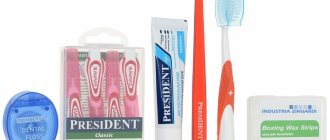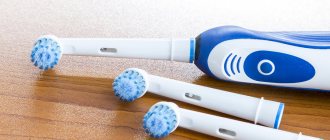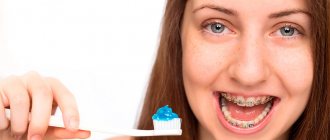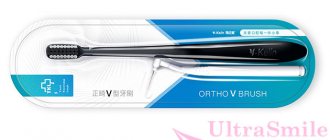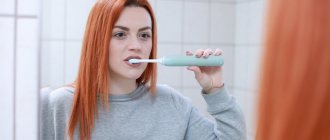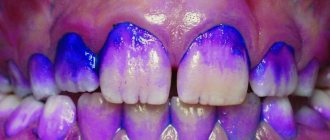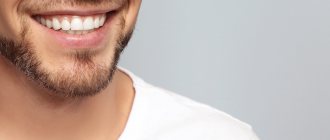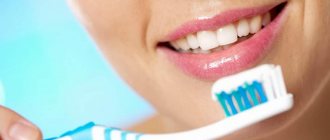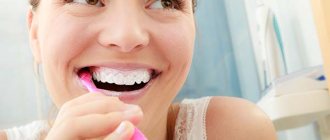It has been proven that using an electric toothbrush allows you to brush your teeth daily much more effectively than using a regular brush. The modern device cleans tooth enamel even in the most difficult to reach places and provides a cleaning quality close to professional. It is not surprising that such devices are used in dental clinics.
However, before you start using an electric toothbrush at home, you need to carefully read the rules and nuances of using the device.
Advantages of the device
Electric toothbrushes have many benefits:
- This device provides a whole range of possibilities for cleaning, massage and care of the oral cavity.
- Moving bristles and several operating modes facilitate and speed up the cleaning process, and also allow you to thoroughly clean interdental spaces and hard-to-reach places, such as “sevens” and “eights.”
- Electric brushes make it much easier to care for orthodontic braces.
- Electric brushes deal with stains from tea or coffee 21% better than a regular manual brush, and with gingivitis - about 11%.
- Using an electric brush prevents the possibility of injury to the gums or destruction of enamel. Provided proper operation and the correct choice of attachments, cleaning with this device is less traumatic.
- Children love brushing their teeth with a children's electric toothbrush. This makes the boring morning ritual interesting for them and they perform it with more enthusiasm.
Important! If you decide to purchase an electric toothbrush, then don’t skimp. Remember, a high-quality device cannot be cheap. The price of branded models starts from 7 thousand rubles. By choosing a cheaper device, you risk buying a fake, which can quickly break down, or, even worse, harm your health.
So which one is better?
Let's consider from the point of view of the ratio of price and quality of cleaning:
- If you are looking for a quality teeth cleaning product but are on a budget, then an electric toothbrush will be just right for you.
- The ultrasonic model costs several times more, but the quality of teeth cleaning is higher.
Important! An ultrasonic brush has many contraindications for use. Due to this, the electric model is safer to use.
Contraindications for use
In addition to the benefits and pleasure of use, electric brushes also have a number of contraindications and disadvantages :
- Before you start using the device, it is advisable to obtain the approval of your dentist, who will evaluate the condition of your teeth. You will also receive the necessary advice and recommendations.
- Those people who have sore or weak gums are not recommended to use an electric toothbrush every day. You can alternate it with a manual analogue and monitor your well-being.
- Thin, sensitive enamel can also be damaged by thorough cleansing with an electric brush.
- The use of an electric toothbrush is contraindicated for people with serious heart disease.
- The main disadvantage of the device is the high cost of the device itself and the attachments, which must be changed regularly.
Mechanical electric brush
In this model, the bristles are driven by a micromotor (built-in). The oscillation frequency is 5-18 thousand per minute. This model is designed to improve teeth cleaning. In fact, it imitates manual cleaning. But due to the accelerated mode, the quality increases noticeably.
Important! It effectively removes plaque while saving your personal time. If you spend about 5-7 minutes with proper manual brushing of your teeth, then the mechanical model significantly reduces this time by half.
Kinds
Electric brushes are divided into several types based on the type of head movement:
- 1D - here the movement of the bristles is carried out in a circle, in one direction;
- 2D - reciprocating movements are performed here, due to which the quality of cleaning is much higher than in the previous version;
- 3D is a very strong cleansing, it is used to combat mildly expressed pigmented plaque.
Important! The 3D nozzle is not recommended for daily use. It is best to alternate it with 2D. Very often they are even included in one set.
Like every product, an electric toothbrush has its advantages and disadvantages.
Advantages of this model:
- effectively and efficiently clean the surface of teeth from plaque;
- if used correctly, it does not affect fillings;
- saving time.
Important! The main disadvantage is contraindications. It is forbidden to use this brush for people with gum inflammation or damaged enamel structure. It can injure or worsen problems with gums and enamel.
How to choose?
In order not to make a mistake and not end up with a low-quality product, you should pay attention to some criteria when choosing a toothbrush:
- Degree of hardness. The most universal is medium. For children and people with very sensitive enamel, a soft one is better. Hard bristles are not recommended for daily use, as they are very traumatic.
- It is necessary to select a set (if there are two heads that rotate in different directions), or with a 2D type nozzle.
- The smaller the nozzle head, the better the quality of teeth cleaning.
- A more convenient nozzle is with a round head. If the head is square, then it most likely has some additional functions.
- A high-quality brush always has a comfortable ergonomic handle.
- The brush handle should have an angle of inclination in relation to the head. It is about 30-40 degrees. Thanks to this structure, you can reach the most distant teeth.
- The bristles should be of different lengths.
- If it is possible to purchase a brush as a set with two different attachments, then take it and don’t even hesitate.
Children's electric toothbrushes, what to do?
Dentists have not yet come to a consensus on whether it is good or bad to use “lazy” brushes in childhood.
Important! The use of ultrasonic and sonic brushes is strictly contraindicated for children. They destroy sensitive children's enamel.
Advantages of children's models:
- simplifies teeth cleaning;
- Children really like to use such models; for them it is very exciting and interesting.
Flaws:
- The child does not acquire the skills to use a manual brush. Experts recommend alternating the use of electric and manual brush models.
- Electric models are heavier in weight. Children sometimes find it difficult to hold it in their hands.
Important! It is not recommended for children under 11 years of age to brush their own teeth with electric toothbrushes.
Top of the best
The best of the best electric toothbrushes - those that are in demand among buyers and have achieved the highest sales ratings - are as follows:
- ORAL-B VITALITY PRECISION CLEAN. Made in the USA. The advantages of this model include: low price, quality of cleaning, long battery life.
Important! Disadvantages include the high cost of consumables and the short duration of battery charging.
- ORAL-B PROFESSIONAL CARE 500. Country of origin: USA. In terms of functionality, it is the same as the previous one. Only this model also contains: a timer, a charging indicator, vertical movement of the brushes, and also increased battery life.
- ORAL-B PROFESSIONAL CARE 5000 D34. Made in the USA. An excellent combination of functionality and technical parameters. Compared to previous models, this device is “stuffed” with a wide variety of functions:
- The set includes 4 attachments. They are decorated with different colors. That is, it is very convenient for a large family. This is a family option.
- The kit includes a nozzle for cleaning and whitening tooth enamel.
- Availability of several modes and speeds. You can combine them and select professional care that suits your teeth.
- A sensor that is responsible for the degree of pressure of the bristles on the teeth (if the brush is pressed too hard, it is triggered).
- Display—Shows information and features you select.
Important! The battery life of this device is about 40 hours.
Children's TOP best:
- ORAL-B KIDS MICKEY MOUSE. Country of origin: USA. It is very popular due to:
- careful, high-quality and soft cleaning;
- the presence of a waterproof handle;
- presence of a timer;
- presence of a stand;
- a color that interests the child.
- HAPICA KIDS. Produced in Japan. Suitable for use by children over 3 years old, does not require the use of toothpaste. It has quite significant advantages:
- The bristles are made of ceramic. The process of brushing your teeth produces negative ions that destroy bacteria.
- Very soft bristles. They safely and carefully clean the surface of children's teeth.
- A budget option. The price is much lower than all its “relatives”, only other brands.
How to cleanse correctly?
Some people believe that an electric toothbrush will do all the work for them. This is true, but only partly. There are important nuances in using this electrical appliance.
Preparation for the procedure
Before starting work, you need to understand the types of nozzles and the mode necessary for cleaning. Most devices have 4 operating modes :
- teeth cleaning;
- polishing;
- whitening;
- sensitive;
You also need to monitor the battery charge or battery charge level. It is optimal to charge the device once a week; as a rule, this is enough. It is convenient to have the charger next to the sink, but charging must be done in a safe manner.
After you have moistened the bristles with water, you can squeeze out a little toothpaste, a pea-sized ball of paste will be enough, and press the button to turn on the device.
Information . Some manufacturers of hygiene products claim that their use is quite possible without toothpaste. However, we recommend not limiting yourself to just one device, but using it together with a paste, irrigator and rinse aid.
Instrument position
Conditionally divide the oral cavity into 4 areas - upper, lower, right and left. You will need to allocate 30 seconds of brushing to each area. The hand should be held at a 45° angle to the gum line, and the brush should be positioned along the front surface of the teeth.
Cleaning the Exterior
Simply guide the working part of the brush, stopping at each tooth for a few seconds. Clean easily, without pressing , the device will do its job on its own.
Some models are equipped with a sensor that is activated when the brush pressure is excessive. Over time, you will learn to control the force of pressing. The external cleaning procedure covers the entire tooth surface, right down to the gums.
Inner surface
Repeat the manipulations not only outside, but also inside. For greater convenience, the device can be rotated vertically. Pay attention to chewing surfaces and interdental spaces. Gently walk over the surface of your tongue. This will help remove even more bacteria and freshen your breath.
Important! Due to the correct pressure and position of the head of the device, a light massage of the gums will be carried out. You just need to install the desired nozzle.
Completing the procedure
For an effective cleaning process, do not increase or decrease the time programmed by the device. As a rule, this is 2 minutes per brushing.
At the end of the hygiene procedure, all that remains is to rinse your mouth with water or a special mouth rinse. Then you need to thoroughly rinse the working part of the brush under running water and set it to dry with the bristles facing up. If you have a sterilizer, then it would be a good idea to treat the attachments to eliminate possible bacteria from their surfaces.
Ultrasonic toothbrushes
Ultrasonic toothbrushes are essentially mechanical too. However, they vibrate at very high frequencies, which is how they get their name. So, in normal mode they usually operate at 12,000 vibrations per minute, in whitening mode – already at 15,000, and in delicate mode, intended for the care of sensitive teeth – at 10,000.
At the same time, the movement of the bristles itself is quite insignificant. Therefore, ultrasonic brushes cannot boast of the ability to sweep away dirt and bacterial plaque from hard-to-reach places. But they transmit this vibration to the teeth - and they independently get rid of such “garbage”.
Thanks to this effect, ultrasonic brushes can easily cope even with mineral contaminants. Yes, they can help quickly get rid of plaque, lighten the enamel in just a few applications and further strengthen the roots. Light vibration is also transmitted to soft tissues, improving blood circulation in them - thereby ensuring the prevention of periodontal disease, stomatitis and other inflammatory diseases.
At the same time, ultrasonic toothbrushes are poorly compatible with artificial elements of the oral cavity. Small, high-frequency vibrations damage the cement that secures these “prostheses.” Therefore, it is not advisable to use such devices for cleaning filled teeth, crowns, veneers and braces.
Ultrasonic brushes can also cause increased sensitivity in some people. If your teeth previously hurt when coming into contact with very cold or hot foods or drinks, you may feel a slight, quickly passing discomfort during brushing. In this case, it is enough to change the nozzle to a softer one or select a less intense operating mode.
Key advantages of ultrasonic toothbrushes:
- Helps cope with tartar. Easily remove any plaque – both bacterial and mineral. Even old stones will break down after a few weeks of daily use;
- Whitens effectively. They are capable of lightening the enamel by several shades even in standard use. Also suitable for “quick whitening” during cleansing after drinking tea, coffee or red wine;
- Improves blood circulation in the soft tissues of the oral cavity. This helps in the prevention of various inflammatory diseases, including periodontal disease and stomatitis.
Key disadvantages of ultrasonic toothbrushes:
- Does not remove dirt from hard-to-reach places. In some cases, bacterial plaque that accumulates in the interdental spaces remains even after brushing. To avoid this effect, it is recommended to follow standard rules of oral hygiene (act not only on the vestibular surface of the enamel);
- May cause tooth sensitivity and make brushing unpleasant. In case of discomfort, it is recommended to use less rigid attachments and intensive operating modes;
- Not recommended for use with dentures or fillings. They can destroy the cement that attaches crowns and veneers, which will lead to a deterioration in the quality of fixation and the possible development of caries or other diseases under the prosthesis.
The abrasive effect of ultrasonic brushes is low due to the low mobility of the bristles. Therefore, they can be used with any pastes, not just specialized ones.
How to use for a child?
Dentists recommend letting your child use an electric toothbrush starting at the age of 2 years. When purchasing, choose a model with the recommended age indicated on the packaging.
First, you will need to clearly show the child by your own example how this is done . While brushing your child's teeth, you will need to hold his hand and guide its movements.
Small children should not undergo such a hygienic procedure on an ongoing basis. The fact is that the enamel layer of baby teeth is not hard enough, and it can be damaged if you are not careful enough.
And electric brushes act on the enamel more harshly than a conventional manual model. Therefore, it is reasonable to teach your child to use a manual brush, occasionally allowing him to clean with an electric device.
You can periodically use a children's electric brush up to the age of six. Then a complete transition to an electric version is possible.
How to use the sound model?
For those who want to evaluate innovative teeth cleaning technologies, there is the option of using a sonic brush. The oral care process in this case is carried out due to sound vibrations. Thanks to the bristles that vibrate at a sound frequency, the gums are gently massaged and blood microcirculation in the oral cavity is improved. This device perfectly cleans teeth and removes plaque without damaging the enamel.
It is believed that sonic hygiene devices work more efficiently than their electrical counterparts . The method of use is similar to the above regarding the use of an electric brush.
Tips for using a sonic brush safely
When using a sonic brush, you must follow some rules:
- Before the procedure, make sure that the battery is charged or that the device has working batteries. If necessary, recharge the brush in advance or replace the batteries with new ones.
- Check that the replacement brush head is securely attached to the body.
- There is no need to perform the usual cleaning movements with a brush - sweeping, circular, etc. To clean, you simply move the head from tooth to tooth.
- Do not press on the brush, as this can damage your teeth and injure your gums. To effectively clean with a sonic brush, you do not need to exert any physical effort. The device does its job perfectly without applying too much pressure.
- Do not touch your teeth with any parts of the appliance other than the bristles. Don't hold the brush in one area for too long.
- A child may only use the device under adult supervision. Make sure to choose a model with age-appropriate features for your child.
- Handle the device with care, try not to subject it to shocks or falls.
- Press the power button with your fingertip, not your fingernail.
And a few more general rules that will help maintain dental health:
- Brush your teeth in the morning after breakfast and in the evening before bed.
- Rinse your mouth with water after every meal.
- Avoid chewing on candy, nuts and other hard foods.
- Remember that a brush is a personal hygiene item and should not be shared with other people.
- Change the sonic brush head every three months. Over time, the bristles wear down, remove less plaque, and can damage your gums. Therefore, be sure to replace the cleaning head with a new one once a quarter.
- Visit your dentist for a checkup twice a year.
- Use other oral hygiene products - dental floss, irrigators, rinses.
Following these simple recommendations will help keep your teeth healthy and beautiful.
Precautionary measures
If you have chosen an electric brush for daily oral care, then do not forget about the need to constantly monitor the pressure of the device on the tissue of the gums and teeth.
It is important to know that excessive force can cause soft tissue injury or damage to the enamel layer of the teeth.
To save money, we recommend purchasing one device for the whole family . Only individual nozzles will have to be changed.
For those who care about the cleanliness and health of their teeth, dentists recommend using electric or sonic brushes. As you can see, using such a device is simple and convenient. With the help of our tips, you will master the art of competent hygienic oral care. And perhaps, once you try an electric brush, you will never go back to using a manual one.
Sonic and ultrasonic brushes - the difference between them
The names of these types of electric brushes reflect the basic principle that underlies brushing your teeth with the help of a particular device. Both types create frequency vibrations of the bristles of the cleaning head due to sound. But the range of frequencies created is different. The sonic brush generates a wave in the audible range and causes the bristles to move at speeds of up to 30-40 thousand per minute. An ultrasonic toothbrush operates with ultrasound at a frequency of more than 20 kHz (our hearing cannot perceive it), and the bristles of such devices move at a frequency of up to several million movements per minute.
Sonic and ultrasonic brushes are much more effective than conventional ones, because it is physically impossible to manually ensure such a speed of movement of the bristles. In addition, sound and ultrasound provide additional effects - a positive effect on the gums, enhancing the therapeutic effect of toothpastes, and cleansing complex and hard-to-reach areas. Conventional brushes are not able to efficiently solve all these problems.

